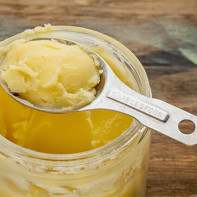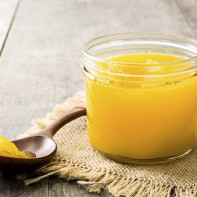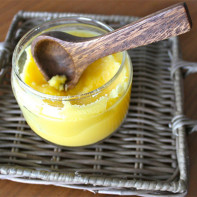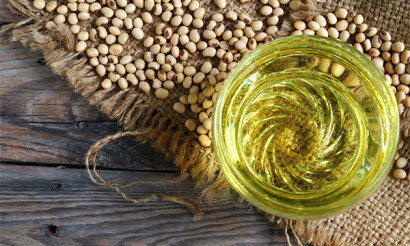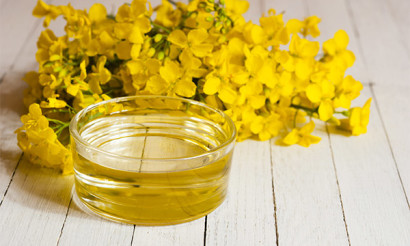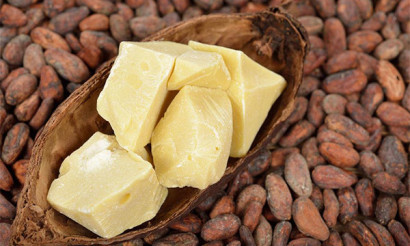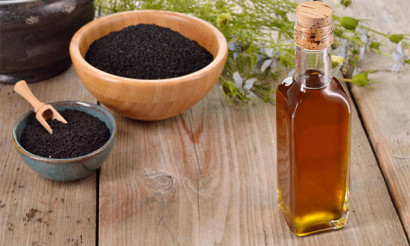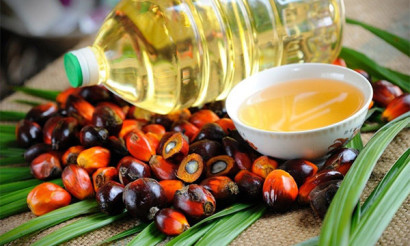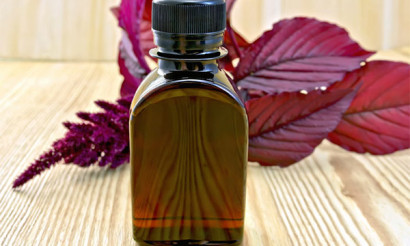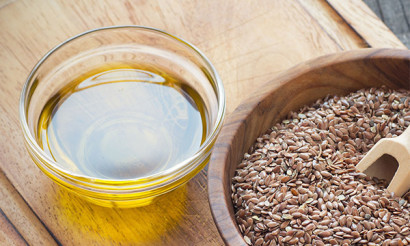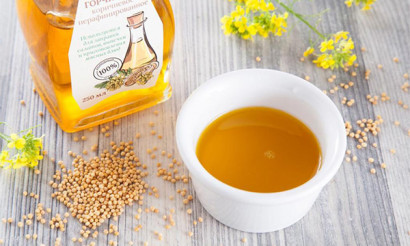Ghee: what is it, composition, useful properties, recipes
When translated from Sanskrit, the word "ghee" (or "ghi") means clarified cow's butter. In India, ghee is referred to as "liquid gold", believed to share the sun's energy with humans. In South Asia (India, Pakistan, Bangladesh, Nepal and Sri Lanka) it is used for cooking, traditional rituals.
- What is ghee oil
- What is the difference between ghee and clarified butter
- Composition and calories
- Useful properties of ghee oil
- General benefits
- For Men
- For Women
- When pregnant
- For breastfeeding
- For children
- For weight loss
- Medical applications
- Ghee oil in cosmetology
- Cooking Usage
- Can One Fry in Ghee Oil
- Harm and Contraindications
- How to choose and store it
- How to Make Ghee Butter: Recipes
- On the Stove
- In the oven
- In a multicooker
- Interesting Facts
What is ghee?
Ghee butter is clarified butter, which does not contain milk protein or lactose. Because of this, it can be consumed by people who suffer from lactose intolerance, irritable bowel syndrome and other conditions associated with problems with fat digestion.
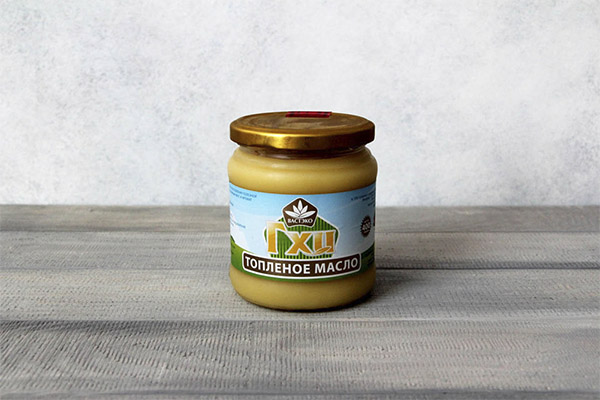
In India and other countries of South Asia, ghee oil is considered a healing product that strengthens the body, eliminates toxins, revitalizes the body, strengthens the spirit, and gives longevity.
What is the difference between ghee and clarified butter
In India and other Eastern countries, the product is prepared by melting cream or butter for a long time at low temperature, during which the sediment and film are separated. It is believed that ghee made according to all the rules can be stored for up to a hundred years.
The traditional Russian recipe for ghee includes adding water and several stages of heating: 10 glasses of water are added to one kilogram of butter. This mixture is stewed until the butter is melted in the container. Then put the butter in a cold place, let it solidify and pour out the excess water through a side hole. Then the process of melting is repeated until the water, which is poured out of the cooled butter, becomes transparent. The resulting oil is salted, transferred to a container for storage, poured on top a small layer of salt solution and stored in a cold, dry place (in the cellar). The shelf life of such a product is up to four years.
The industrial method of making melted butter also differs from the traditional method of manual preparation. Butter is melted at a temperature of 40-50 degrees, then separated from the milk protein, milk sugar and water in a centrifuge. The resulting product is then quickly heated to 100 degrees in a vacuum boiler, which evaporates the remaining water. The butter is then whipped and packaged.
All three products are free of milk protein and lactose and contain a minimum of water. However, the recipe, which requires unhurried and careful handling of the product, allows you to preserve maximum useful properties.
There are other differences between the product and other types of ghee:
- Ghee can withstand temperatures up to 180-200 degrees and has a higher combustion temperature than regular ghee or butter, making it ideal for cooking with it.
- Conventional ghee raises cholesterol in the blood, but ghee, due to its purification during cooking, helps to reduce cholesterol levels.
- Ghee differs from ghee in recipes of other cultures by the temperature at which it is produced. The former is cooked at low temperatures, which exclude boiling, for several hours.
- Melted butter in European traditions usually does not imply additional properties other than nutritional. Ghee has been attributed medicinal and cosmetic properties. In Ayurveda it is believed that a person who uses it regularly becomes more joyful, develops creative abilities, turns to God and feels unity with the whole living world. You get a feeling of support and help from external forces, self-confidence, fear, despair and sadness disappear, the energy as a whole becomes stronger, cleaner, filled with the power of the sun. Ayurveda assures that ghee oil gives clarity of perception, motivates and inspires.
Composition and calories
Ghee oil is a very caloric product. One hundred grams of ghee contains around 900 kilocalories, which is around 50% of the daily allowance for an adult. There are 99 grams of fats per 100 grams of ghee oil, which is more than 140% of the daily requirement of fats. Therefore, consumption of this product requires reasonable caution. It also contains about 0.6 grams of carbohydrates and 0.3 grams of protein.
One of the key elements of ghee oil, which gives it so many useful properties, is linoleic acid (5-6% of the volume). This acid is not produced in the body, it is very important to get it with food in sufficient quantities.
Vitamins in ghee: A, E, D, K and B3. Trace elements: calcium, sodium, potassium and chlorine.
Useful properties of ghee oil
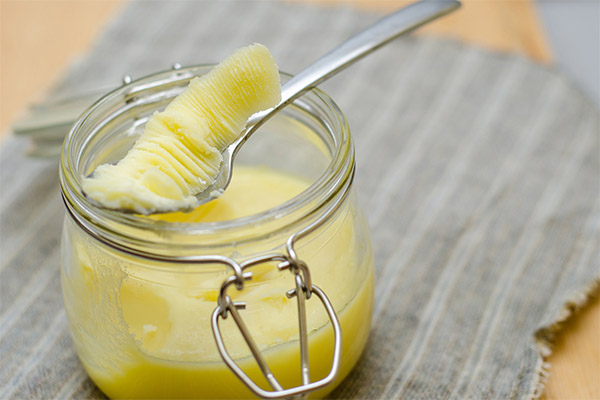
General benefits
- During the production of ghee oil, the milk sugar, lactose, is melted down. Thus, people who suffer from lactose intolerance can consume this product, unlike regular butter.
- The relationship between vitamin A deficiency and various eye diseases has been proven. Ghee oil contains large amounts of fat-soluble vitamin A, which makes it a means of preventing eye diseases and a companion product in the treatment of eyes.
- The product stimulates the appetite as well as the production of gastric juice, which helps in better digestion and assimilation of food. In general, the product, due to its content of butyric acid, is considered unusually beneficial for the gastrointestinal tract.
- Ghee oil contains medium-chain triglycerides, fats that do not require bile and therefore pancreatic enzymes to break down. Thus, this product can be consumed for cholecystitis, pancreatitis, hepatitis and other diseases when the body cannot fully assimilate fats.
- Ghee oil contains substances that stimulate the growth of T-cells, which are the first to fight against viruses and bacteria, so this product helps to strengthen the immune system.
- Vitamin K2 in ghee oil is the most important factor in bone density and prevents bone fragility. It also contributes to the absorption of calcium, the most important element of healthy bones, improves blood clotting and has a beneficial effect on brain function. At the same time, one teaspoon of ghee oil contains the daily norm of vitamin K for an adult.
- Ghee oil contains a large amount of unsaturated omega-3 fatty acids, which are essential for the health of the cardiovascular system and help reduce cholesterol levels. Other oils used for cooking have much lower omega-3 content.
- Since ancient times, ghee oil has been known to relieve joint pain and treat joints in general. The fats, when taken orally and applied externally, help to produce joint lubricant and reduce inflammation.
The main source of knowledge on the medicinal use of ghee oil is Ayurveda, the traditional system of medicine in India. It is part of many Ayurvedic medicines and is considered a life-extending, regenerating and restorative agent for the body's cells.
For men
Due to the fact that one of the main causes of disease and mortality in men in developed countries is cardiovascular disease, the use of ghee, which contains substances that prevent atherosclerosis and stimulate tissue metabolism, is important for men of all ages.
Also ghee oil is useful for men because it has a mild sedative effect, helps relieve stress after a busy day, reduces stress, improves memory and strengthens the nervous system.
Ayurveda considers ghee oil to be a key product in men's nutrition. Consumption by men of this product, which carries the power of the sun, inspires them, encourages them to act for the benefit of the family and makes them feel joy at work, clears the mind of profanity and illicit motives, gives strength to accept the laws of society and follow them.
Ayurveda also considers this product a natural aphrodisiac. Ghee butter with milk is considered an excellent tonic, rejuvenating and empowering drink.
For women
Ayurveda encourages women to consume ghee oil as it, by saturating the energy of the sun and its accompanying joy, helps women to become more chaste and gives strength for spiritual development. Ayurveda masters believe that women who regularly consume ghee oil become happier, their joints become flexible and agile, their voice becomes gentle and soft. In general, due to its cosmetic properties, women in South Asia and more recently in other countries appreciate ghee oil as an affordable remedy for rejuvenation, anti-wrinkle, facial smoothing and skin tone improvement.
Ayurveda recommends it for women who need to restore hormonal balance.
In traditional Indian medicine, ghee oil is used to treat female genitourinary organs, massaging and applying it internally.
When pregnant
Ghee oil is rich in vitamins A, E, D and K which are essential for the formation of the child's bone, nervous system and other body systems.
In Ayurveda, a source that has been describing ghee in medicine for centuries, it is recommended that pregnant women consume it throughout their pregnancy.
However, one should keep in mind that ghee is a high-calorie product, so it should be consumed in moderation, not more than 30 grams per day to avoid gaining too much weight.
In Asia, topical application of ghee shortly before childbirth is popular to prevent unpleasant complications during childbirth. Official medicine has no consensus on whether such procedures help. However, many of those who have used such methods have been satisfied with the results.
When breastfeeding
The use of this product during breastfeeding is possible and even necessary to saturate the mother's body with useful substances. Ayurveda also contains descriptions of recipes that help stimulate breast milk production, with mention of ghee oil. For example, the herb shatavari in the form of powder, pastes or tablets is believed to help enhance lactation, but for the best effect, you should drink water with dissolved ghee oil or fry it with sugar in ghee oil.
For babies.
Most children in South Asia, Iran and many Arab countries consume ghee oil every day in fairly large quantities. Moreover, there is a tradition in India of giving a newborn baby a small piece of ghee butter.
Most families in the East use ghee to dress salads, add it to sweets and fry food with it. However, for all its benefits and wonderful taste, its use should be limited for children. One tablespoon a day is enough.
Interestingly, this product is used not only in food, but also as a massage oil for infants and to moisturize the skin.
Scientifically proven high content of linolic acid in ghee oil makes it important for children as this acid promotes growth and development of all body tissues.
For weight loss
Usually consuming oil is associated with weight gain, and when losing weight it is recommended to limit the consumption of foods rich in fats. However, ghee oil contains no dangerous trans fats, and on the contrary, it contains lipolytic (fat-burning) substances, which prevent fat deposition, and linoleic acid, which promotes weight loss.
Ghee oil contains butyrate (butyric acid), which regulates insulin levels and has an anti-inflammatory effect. It is a short chain acid, so it is absorbed faster and easier than long chain fatty acids, which helps stimulate weight loss.
Thus, if you consume this product in reasonable amounts, no more than one or two dessert spoons a day, weight gain should not occur.
To eliminate toxins from the body, nutritionists recommend taking a solution of ghee oil in warm water. After taking it, you should drink water with lemon, which will speed up the metabolism.
In Ayurveda, it is recommended to mix ghee oil with mashed dried fruit. The mixture with a paste of dates or other fruits is a nutritious dessert that promotes weight loss and body health.
Medical uses
Ghee oil is used in many Ayurvedic medicines due to its ability to combine and enhance the healing properties of the herbs with which it is mixed. At the same time, it is also used as an independent substance for prevention and treatment.
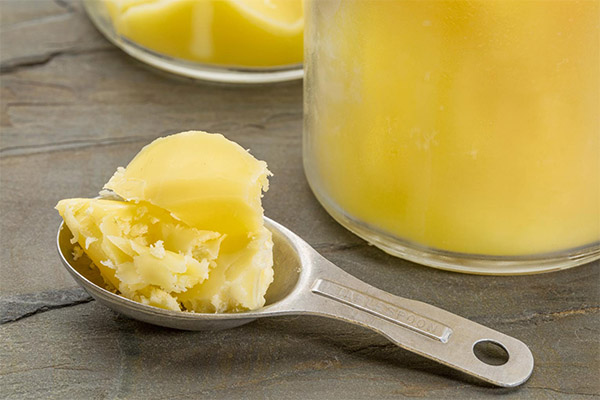
- Ghee oil is considered a general tonic that helps to improve the immune system.
- Dried fruits with ghee oil, almonds, cinnamon, coriander, saffron, walnuts and pine nuts should be mixed and sour cream or ryazhenka should be added if desired. A small portion of this mixture gives strength for the whole day, with regular use strengthens the body and prevents colds and other diseases.
- Ghee oil is a traditional remedy for sore throats, colds and coughs. Soothing and warming properties guarantee a long-lasting effect.
- You can masticate a spoonful of oil, take the product dissolved in water or milk, with the addition of honey and other spices and seasonings.
- After fresh wound healing (scarring), ghee oil helps to heal burns and repair damaged skin faster.
- Skin problems caused by irritation or dryness, lack of moisture, can be eliminated by applying ghee oil and a light massage. The massage oil should be warmed up a little. A small amount should be used.
- Treatment of redness and irritation of the eyes can be done by putting ghee oil in the eyes. This procedure should be done very carefully, preferably under the supervision of specialists.
- It is believed that the use of ghee oil helps to combat constipation.
- Ghee oil mixed with fennel, nutmeg, cardamom and other spices helps improve digestion. It is important to consult an Ayurveda treatment specialist to recommend the exact composition of the therapeutic mixture depending on the causes of digestive problems.
In traditional oriental medicine, it is believed that the potency and therapeutic effect increase in proportion to the age of the product. For medicinal purposes, ghee oil that has been aged for a year or more should be used. Over time, ghee oil becomes very hard. One has to boil it for several hours to be able to consume it. But the valuable properties acquired over the years are worth the effort. Ayurveda believes that ghee oil that is ten or more years old helps in healing wounds as well as the following ailments:
- Poisonings and fainting.
- Ear ailments, headaches.
- Migraine (it is necessary to rub ghee oil on the hands, feet and temples before going to bed; to achieve and consolidate the therapeutic effect, the procedure should be repeated for 10-15 days; another way is to put 1-2 drops in the nose).
- Pathologies of the female reproductive system.
Ghee oil in cosmetology
Ghee oil is used to saturate the body, hair, face with useful substances:
- Massage with ghee oil will help warm and make the skin soft.
- This product is believed to help detoxify and revitalize the skin and relax the body.
- In its pure form, it can be used as a natural lip balm.
- A ghee oil mask for the feet will moisturize and soften the skin in just one night.
- Daily application of ghee oil on the skin around the eyes will help lighten dark circles and remove signs of fatigue.
- Consumption of the product promotes collagen production, which makes the skin smoother and firmer.
- Ghee oil can be used for baths. To do this, dissolve a few spoonfuls in warm water. After a few treatments the skin of the body will be noticeably smoother and firmer.
Below are a few cosmetic recipes with ghee oil for hair and face skin.
Recipes with ghee oil for hair
- For split, weak and thin hair: one tablespoon of ghee oil, two drops of lavender essential oil. Apply the oil for one hour and then wash it off with shampoo.
- For dry and unruly hair: apply equal parts of ghee oil and olive oil for 15 minutes and then rinse with shampoo.
- To stimulate hair growth: apply a mixture of ghee and coconut oil for one hour and then rinse with water.
Recipes with ghee oil for skin
An important rule is that the masks must be heated for even application and effect. The best effect of masks with ghee oil will be achieved with regular application (at least once a week), and provided that the skin before application is well cleansed and after application - well moisturized.
- To even out face tone and problematic oily skin: one tablespoon of ghee oil, one tablespoon of honey and four spoons of apple puree mix, warm up and apply to the face. After 15 minutes, rinse the mixture off thoroughly. Instead of apple puree you can use oat flakes softened in boiling water.
- For skin rejuvenation and fighting wrinkles: one tablespoon of ghee oil, one tablespoon of turmeric, four spoonfuls of mashed potatoes. Keep the mask on your face for no more than 15 minutes.
- For nourishment, rejuvenation and whitening: one tablespoon each of ghee oil and honey, two tablespoons of castor oil, two drops of iodine. It is important to apply the mask to the face immediately after preparation of the mixture. This mask can also be used for hands and neck. Wash off after 15-30 minutes.
The above masks together with ghee oil contain useful auxiliary ingredients. However, even a simple facial massage with oil diluted with water and applied diluted oil will help smooth and soften the skin.
Cooking Uses
Dishes cooked with ghee oil acquire a delicate buttery taste with a touch of nutty flavor. It can be used in salads, pastry, baking, cooking vegetables and meat.
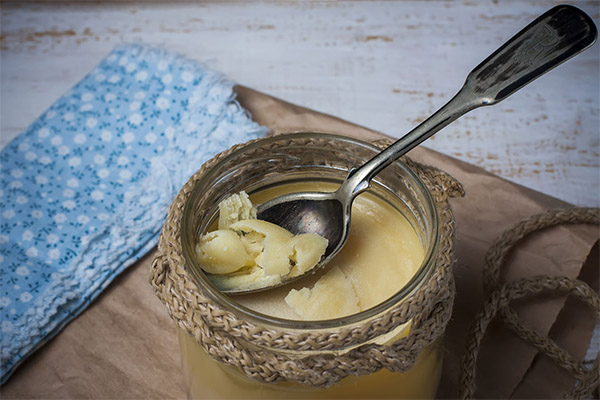
Can you fry in ghee oil?
Due to the fact that ghee oil is melted butter with a high degree of purity, it can be used for frying. Even at 180-190 degrees Celsius, it does not produce combustion products or carcinogens. Therefore, it is possible to fry ghee several times and will not leave an unpleasant taste. Before using it again for frying, ghee oil should be strained to remove the remains of food that has been cooked in it. If the product has an unpleasant odor, the oil darkens and starts to burn, it should no longer be reused for frying.
To get the best frying results, do not overheat the oil, as the food will not cook through it. Also, you should not be in a hurry to start cooking, unheated oil will not be able to soak up enough food.
Harms and contraindications
Consumption of small amounts of ghee oil is considered harmless, but one or two tablespoons per day should be limited in case of liver diseases, stomach diseases and overweight problems.
A study by Indian doctor Ram Singh describes an Indian paradox: The country's population is mostly underweight and thin, but many have cardiovascular disease. The doctor attributed this to the fact that regular consumption of ghee oil in quite large quantities leads to vascular problems and related diseases. There has been a debate about how dangerous fats are for the heart and blood vessels for many years, but one thing is certain: abusing fatty foods is dangerous to health.
Other contraindications to the use of ghee oil are neoplasms, benign and malignant. Breast masses in women, polycystic diseases are contraindications for regular consumption of ghee oil, as it can stimulate their further development and growth.
It is not recommended to take ghee oil when any chronic or acute stage of diseases is exacerbated. In this case, first of all, you should consult a doctor of traditional evidence-based medicine, buy out acute conditions or enter the remission stage and only then start using this product as a therapeutic and prophylactic agent.
How to choose and store
To choose a ready-made ghee oil one should look for two features: it should be yellow, light, homogeneous and have a pleasant creamy smell. Oil with dark specks, with a musty or sour smell can also be used for cooking, but the taste of the food will not be ideal and it has few useful properties.
To store small amounts of ghee oil, which is planned to be used every day, no special storage conditions are required: the room should be cool, but not cold, without direct sunlight. It is believed that the product should be stored without a refrigerator, but even there it does not lose its properties, only it needs more time to heat up. If you plan to store ghee oil for a long time to get an aged product, it should be kept in a dark, dry place and a hermetically sealed container.
How to make ghee butter: recipes
The cost of ghee oil melted in the traditional way, without a centrifuge or vacuum machine, is about 1500 rubles per kilogram.
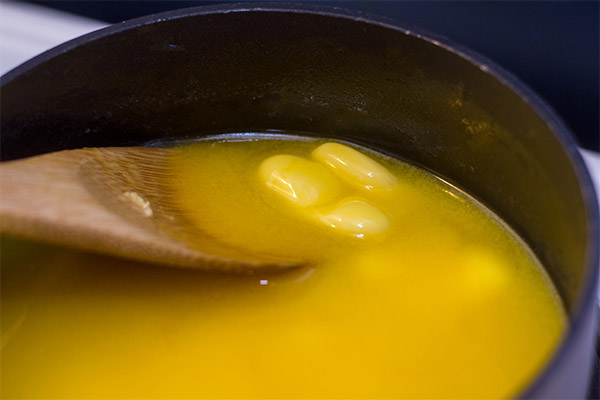
The basis of success in making ghee oil is quality raw materials. Traditional recipes in India use cream, but the desired result can also be achieved with butter. The fat content of the oil must be 82.5%, the oil must not be salty or flavorful. It is desirable that the product should be made according to GOST.
Before you start making ghee, you should check the oil you bought for it in three steps: it should boil in a hot pan with small bubbles, when heating it, there should be no foam and no unpleasant smell. Quality butter becomes brittle when frozen and falls apart when you try to cut it. The third check: a piece of butter should be dissolved in boiling water and the resulting solution should be checked. It should be homogeneous, without any sludge or flakes.
At the preparatory stage, it is worth making sure that you have all the necessary utensils: the bottom and walls should be thick, keep the temperature and not let the sediment stick, aluminum containers should not be used.
The process of melting is long and takes up to an hour and a half (to turn two packets of regular butter into 350 grams of ghee). To get about 700 grams of ghee, you will need more than two hours and one kilogram of butter. To speed up the process, you can cook the product in the oven, which will reduce the cooking time by about 30 minutes. You can also add a few drops of lemon juice or a bit of citric acid. The quality of the ghee will certainly not improve.
It is believed that the sludge produced by melting the oil can be consumed as food to add to baked goods or cooked food. In India, the sludge is used to dress salads, as a sauce to various dishes. It is important to remember that the film and sludge, unlike the oil itself, can be stored for no more than three days.
After a successful experience in cooking ghee oil, you can try experimenting and adding spices to it - cinnamon, coriander, allspice, cloves.
In Ayurveda, it is believed that one should be in a good mood while cooking oil, the mind should be free from evil thoughts and worries. According to traditional Indian teachings, the food one cooks absorbs one's condition and mood. Therefore, cooking ghee oil should be done in joy, with good intentions and love.
On the stove
The pot for melting should have a thick bottom with non-stick coating, hold heat well and be two or three times larger than the volume of melted oil. For example, if you make ghee from one kilogram of butter, the volume of the pan should be 2-3 liters.
The fire on the stove should not be strong at all. The oil should not sizzle and darken. If it does, you should reduce the temperature of heating. After all the butter has melted, the fire should be increased so that the product boils. After boiling, reduce the heat again and leave the contents of the pan to warm up. Do not cover the pan with the lid, so that the oil does not boil and escape. During the heating, under no circumstances should you stir the mass. All impurities themselves will settle to the bottom. The crust that forms on top should be removed as it arises.
The resulting butter should be light with a golden hue and a pleasantly sweet flavor of cream. If it is dark and smells unpleasant, it can still be decanted and used in food. But it will not have medicinal properties.
After cooking, ghee oil should be poured immediately into a jar for storage, after filtering it out to prevent sediments from getting into the jar.
In the oven
Ghee oil is convenient to cook on the stove, if a small volume is required for occasional consumption. But if it is to be used for treatment or to make cosmetic masks, large amounts are needed, and for their preparation the method of stewing in the oven is better suited. This method is also convenient because in the oven the crock with butter is heated evenly, the product does not stick, the sediment settles without interference.
To prepare ghee, the oven should be heated to 150 degrees Celsius and the pan with the butter should be placed there. For three packets of butter, it will take about an hour and a half, before the contents of the crock becomes golden and covered with a transparent crust. The resulting product must be carefully strained and poured into a dish for storage.
In a multicooker
The basic principles of cooking ghee oil in a multicooker are the same as in other crockery. The volume of dishes should be much larger than the product, it is not allowed to boil, do not cover with a lid. Butter should be cut into pieces of 50-100 grams for more even melting.
The beginning of the cooking process should be carried out on the mode "Baking" or other mode with a temperature of 80-90 degrees Celsius. In about 10-15 minutes, the butter should melt completely and begin to boil. After that, the temperature should be reduced, for example, switch the multicooker to "Stew" mode, and leave the butter for an hour and a half, periodically removing the film formed on top.
When the film stops forming, and the liquid becomes clear and golden, you can strain and pour the resulting oil ghee.
Interesting Facts

- The recipe for ghee oil has been known since long before our era. It is one of the oldest products known today. In many Eastern countries in ancient times, the supply of this product was considered an indicator of the wealth of the family, because it required a lot of milk and a lot of time to produce it.
- Ghee oil is widely used in religious rituals in Asian and Middle Eastern countries because it is highly refined, does not burn and has a pleasant aroma. Rituals associated with childbirth, initiation, weddings and funerals are not without ghee oil lamps.
- This product is one of the main components in the fire-offering ritual. During the recitation of mantras, rice and ghee oil are added to the fire, thus achieving the desired effect on the environment.
- According to ancient Indian legends, the cow is considered the first form of life on Earth and the mother of humanity because she gives people her milk. Thus, the consumption of products from cow's milk, such as ghee oil, helps to cure any diseases. It is believed that it not only relieves the symptoms of disease, but also heals a person's karma.
- Tibetan monks prepare ghee oil according to a special recipe: the temperature at which it is melted is about 15 degrees Celsius. This ensures the preservation of its beneficial properties and the absence of harmful impurities. Tibetan ghee oil with an age of more than a hundred years can be worth more than two million dollars per kilogram, as many believe it can prolong life and even grant immortality.
- Traditional Indian teachings specifically state what happens to a person if he does not get enough ghee oil in his diet. Man begins to struggle for power, becomes prone to hoarding, justifies his laziness and stupidity, ceases to resist momentary impulses and whims, shows pride, disrespect, selfishness, tendency to violence. Slouchiness appears, hair thinning, bones become brittle.
- Since ghee is associated with the sun's energy, it is recommended to consume it during the daytime, ideally between 11:00 and 14:00. An exception to this rule would be to use it before going to bed, with tea or milk, to combat insomnia and reduce anxiety. In the cold season it is allowed to use ghee oil for warming effect, especially for sick and weak people.
«Important: All information on this site is for informational purposes only. for informational purposes only. Consult with a health care professional before using any recommendations. specialist before using any of the recommendations. Neither the editors nor the authors shall be liable for any possible harm caused by materials."


